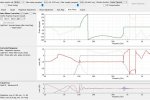Re: FIR filters
This. Phil said it more clearly and tactfully than I could have. -F
The primary advantage of FIR filters is ability to manage the filter magnitude response in a much more finely grained manner than an IIR biquad. Causal, minimum phase FIR (i.e. no taps before reference time zero) are a very powerful tool, and far preferable than futzing around with a bunch of biquads trying to achieve the same goal.
Screwing with phase is a secondary process, and optional, with FIR.
This. Phil said it more clearly and tactfully than I could have. -F

